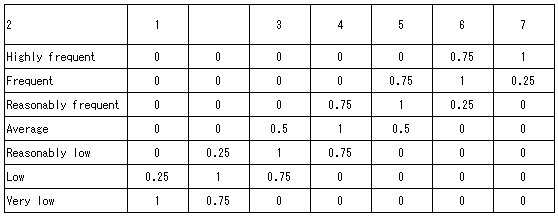Probability distributions and detailed data are used to describe and deal with the importance degree of equipment. However in many cases it may be difficult to precisely determine the parameters of probability distributions and detailed data due to lack of evidence, specially in modular design because each module consists of many equipment, pipes, and valves etc. Therefore fuzzy function is attempted to use to resolve this problem.
In fuzzy theory, linguistic variables can be characterized by their membership functions to a set of categories which describe the degrees of property about ship. For instance, if U=(1,2,3,…,n-1,n) represent a set of categories, the linguistic variables 'very good', 'good', 'average' and 'poor' may be modeled by[1,2]:
'very good' ={0/1,…,0/n-3,0/n-2,0.75/n-1,1.0/n}
'good' ={0 11,…,0.5/n-3,1/n-2,0.25/n-1,0/n}
'average' ={0/1,0.25/2, 1/3,…,0/n-2,0/n-1,0/n}
'poor' ={1.0/1,0.75/2,0/3,…,0/n-2,0/n-3,0/n}
Where the integers in the numerators of each term within the brackets represent the categories and the real numbers in the denominators stand for the membership degrees.
The membership values for the components in U belonging to each of the linguistic variables 'very good', 'good', 'average' and 'poor' can be denoted as follows in Table 1 if n=7:

In the past the failure rate is only considered in engineering calculation. Actually there are other factors must be considered, here a new concept of failure degree is introduced. The failure degree can be defined as a result considered the failure likelihood, consequence severity and failure consequence probability. It can be represented withμf.
Failure likelihood can be defined as the failure occurrence likelihood of each module of system. It can be represented withμl and as shown in Table 3:
Failure consequence severity can be defined the severity of resulting effects. It can be represented withμsand as shown in Table 4: